Setting the Table for Success
Written by Katie Bertrand, RECE
One of the biggest parts of our day as a home child care provider is mealtime. This takes up not only a large amount of physical time in a day, but as every home child care provider knows, it also takes up a large amount of mental space – always thinking about the next mealtime or snack.
Mealtime can also be one of the biggest challenges a home child care provider faces. Feeding little ones can be hard enough, but even more so as children are in their peak developmental stage for attempting to gain some control in their lives.
Rather than thinking of mealtime strictly as a routine you need to check off on your daily to-do list, try thinking of it as another learning opportunity in your day. We tend to get so caught up in what each child is consuming at that specific mealtime and if it’s healthy, the right quantity of each food group, balanced, etc. So, to eliminate some of the stress, rather than being consumed by the child’s intake and acceptance of new foods day to day, try and take a weeklong snapshot of their overall eating habits. This will help to remove some of the mental load that comes with toddler mealtimes. Children’s appetites and moods will change from day to day, so what they eat in a week, instead of one day, is a better indication of how they are doing. Remember, when offering little ones new foods, it can take up to 10 times for them to accept and get used to a new food, so don’t be discouraged if they don’t devour your new chickpea dish right away.
There is a lot of advice out there, and many strategies suggesting what to do and what not to do with picky eaters…I may have read them all! “You are not a short order cook!”, “Don’t give them a choice, you get what you get!”, “Enforce the rules: no TV if you don’t eat this broccoli”, “Don’t let them snack between meals”, etc. Maybe some of these sound familiar to you too?
Well, after 13 years of feeding numerous little ones of various ages and stages, I can tell you, that none of those options work in the long run. My number one hands-down advice to anyone struggling with picky eaters and mealtime stress is to take a step back and evaluate the environment you are creating around mealtime. Children make emotional connections to certain routines. If mealtime is rushed, chaotic, stressful, or all of the above, their eating habits may be affected, leading to a struggle.
One way to help you shift the narrative and transition to a more positive mealtime experience is to keep in mind the “division of responsibility” when it comes to mealtime:
- The parent/caregiver is responsible for what foods to serve, and when and where to eat.
- The child is responsible for how much and whether or not they eat.
Keeping this in mind relieves so much stress and pressure, from everyone.
What emotional connection are you attaching to mealtime? Mealtime should be calm and relaxed – it’s a great opportunity to engage in conversation and work on language skills. I used this time of day to chat with the children about what they did last night when they got home, what they had for dinner, or what they enjoyed doing at the park that morning. This is one of my favorite daycare memories. Keeping them entertained with back-and-forth conversation removes the pressure and focus off of what they are eating. Observing the other children and eating while they engage in conversation helps toddlers to relax and enjoy mealtime. Sometimes something as simple as changing the name of the food you are eating to a silly name can help too. “Today we are having crocodile egg sandwiches!” – there’s nothing a toddler loves more than to see an adult being silly.
Along with this, make sure you are creating a positive environment, if the children associate mealtime with a calm and positive emotion, they will be more likely to want to try the new foods on their plates. Your reaction to the food you serve can play a large role in how it’s received. Model the excitement and joy of enjoying fresh food bought at the farmers market, trying something new, or sharing one of your favorite dishes.
A regular tactic I used, was including children in the lunch choice. You have likely already planned what you’re having for lunch, but they don’t need to know that. Let them think they are making part of the choice. On our walks in the morning, we would talk about what we should have for lunch, and I would give them some choices from what I had already planned out. Once they had made the pick, I’d talk it up. For example, on our walk home from the park I’d ask “Who’s excited to have yummy spaghetti for lunch?”.
Another strategy to making mealtime a positive experience (and you may not want to hear this!) is to “embrace the mess”. For children, eating is a sensory experience: smelling the food, touching the food, tasting the food, etc. So, if most of the yogurt ends up on their face and in their hair, that’s ok. Rather than get frustrated, spin the conversation to a positive. “Wow, you must have enjoyed that yogurt”. Getting messy is normal, and in most cases, as they grow and develop the mess will decrease. Until then, take a deep breath and adjust your expectations.
Finally, remember mealtime is fun! Arrange their fruit in happy faces, use cookie cutters to cut the sandwich into dinosaur shapes, and when all else fails with those picky eaters, offer them DIP!! No toddler will ever turn down “DIP” 🙂
___________________________
Looking for great resources? Check out the following links:
Division of Responsibility: www.ellynsatterinstitute.org/wp-content/uploads/2015/08/ELLYN-SATTER’S-DIVISION-OF-RESPONSIBILITY-IN-FEEDING.pdf
Healthy Eating: https://www.ottawapublichealth.ca/en/professionals-and-partners/healthy-eating.aspx
Children’s Nutrition – Picky Eating: https://www.unlockfood.ca/en/Articles/Childrens-Nutrition/Picky-Eating.aspx
Nurturing Kindness in Young Children
Written by RaDeana Montgomery, RAM Media
Even before children outwardly display acts of kindness, they can already feel empathy. As a home child care provider, you can help children express these emotions by engaging in discussion and introducing them to the ideas of empathy, generosity, and kindness in an understandable and meaningful manner. Imparting the value of kindness to children is one of the most crucial lessons we can give future generations. But, fostering compassion begins with leading by example.
Children are exceptionally perceptive and often learn how to treat others by closely observing the adults in their lives. As a caregiver, you have an opportunity to model kindness in every interaction with your children. Leading by example allows children to observe and emulate your behaviour. Small acts of kindness like holding the door open for someone else, offering to help, or just saying hello when out for a walk are great ways to teach children about the power of kindness.
As adults, we understand that there are times when being kind to someone can be difficult, particularly when that person hasn’t been very kind to us. Yet, one of the most valuable lessons we can impart to the children is the importance of doing what is right and showing kindness when it’s difficult. Once more, it’s essential to lead by example so they can learn from our actions.
Utilizing personal stories, providers can share their own experiences to illustrate the impact of kindness, generosity, and empathy in real-life situations. Share examples of when you received kindness from others, including the children in your care, or when you extended kindness to someone else. Always highlight the positive emotions you felt from receiving or giving kindness. Alternatively, encourage children to reflect on their acts of kindness and consider the positive emotions they experience when they are generous and compassionate. This practice will help them learn to be kind without expecting rewards and to derive satisfaction from their benevolent actions.
Young children may still lack the vocabulary to articulate their emotions effectively. You can assist them in finding words to express their feelings by acknowledging and naming the emotions they are experiencing. This approach can also help them relate to and recognize similar emotions in others. Open communication about emotions is crucial. When your child is upset or frustrated, encourage them to express why they feel that way. Create a safe space for them to share their feelings, reassuring them that you are always there to listen. Helping children make sense of their emotions and facilitating their ability to identify them in others equips them with valuable skills for building positive relationships and friendships with peers. This also empowers them to express themselves in group settings confidently.
In summary, teaching kindness to children benefits them individually and creates a more compassionate, inclusive, and harmonious society. Kindness equips children with the skills and values necessary to navigate a complex and interconnected world while promoting their own well-being and that of those around them.
What I know now that I wish I knew then…
Growing up in a home daycare. Written by Katie Bertrand, RECE
I grew up in a small town, and from when I was little until my early adolescence, our house was “the house”—the house that everyone in the neighborhood was a part of.
My mom ran a home-based daycare, and when you live in a small town and your mom runs a daycare there is a pretty good chance everyone knows you, and at one time or another every neighborhood child has called your place a second home for 9 hours a day. We always had a house full of little ones, some for a long time, some that just came for a while, some that are still a part of our life, and so many that left lasting memories.
When you are a child living in the home of a home daycare you become accustomed to a life where nothing is only yours. Everything is communal, you share toys, you share living space, you share pets, and even your bedrooms are transformed into nap rooms in the afternoon. There were times when I hated it, and wished I could just have my own space. I’m sure on many occasions I uttered the words “I will never run a home daycare when I grow up”.
Well, I grew up and it was time to decide on where to go after high school. I decided to get my diploma in Early Childhood Education with the plan to continue to teachers’ college. Still with the mindset that “I will never run a home daycare as my mom did”. Time went on and life happened and after many years of working in a licensed child care centre, I found myself at a turning point. I had my first child…how could I justify putting them in child care when that was my life? So, it happened, the thing I said I would never do—I opened a home daycare.
I was lucky and found some great families right off the start and slowly, as the years progressed, my business grew. Along came my second child and this career choice made even more sense. Being a RECE, I ran my daycare business with a play-based learning philosophy and a heavy emphasis on outdoor time. Something I learned from watching my mom run her business, you know…that business I said I would never do when I grew up.
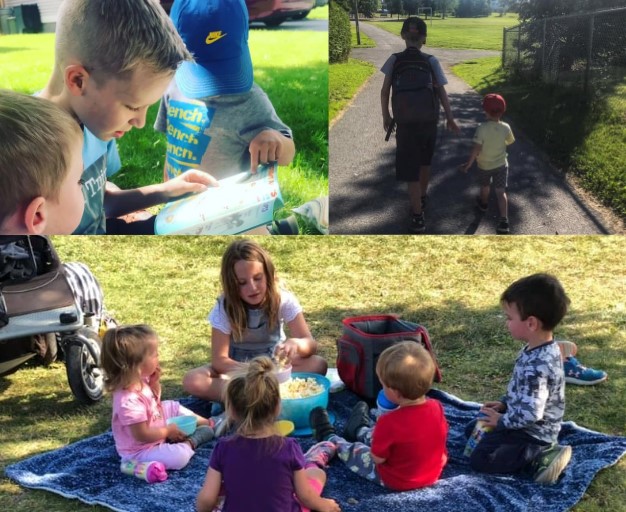
Over the years many children have come through my doors and so many times I have thought back to my childhood and all the children that came and went. Every job has trade-offs, but running a home daycare has unique ones. I tried to be aware of the fact that my children and husband were sharing their home with five other families, and sometimes privacy was at a minimum. When they came down in the morning for breakfast there was a high possibility other children were sitting at the table already eating, and one of my children is not a morning person, so the little ones were not always greeted with a happy face and that was ok, because this was their home and their space, and they didn’t always need to be “on”.
I am pretty sure I’ve heard my children utter the words “I will never run a daycare like my mom”, but now that time has passed and my children are growing into young adults, I know now what I wish I realized when I was their age, that growing up in a home daycare was a wonderful childhood. The lifelong skills I learned have followed me throughout my whole life.
My two children and two dogs learned so much as we welcomed new little ones into our home who had never been away from their parents. They learned to be patient and empathetic as mom doesn’t have 5 arms. They learned how to share and communicate, from a very young age sharing mom was part of the job, and that was not always easy. They also learned that mom was always there for drop off and pick up from school, and there were always five smiling faces so excited to see them walk in the door. They learned there were many other moms and dads in their world now who were always excited to hear about all their accomplishments at morning drop-off. What I hope they eventually learn, like I did, is that being a home daycare provider is one of the most important and rewarding jobs and when someone chooses this profession, they are choosing to have a lasting impact on so many little lives that shape our future.
Fall Fun With Your Toddlers & Preschoolers
Written by RaDeana Montgomery, RAM Media
Autumn is a wonderful and magical time of the year, especially for children. The vibrant colours of the leaves, the crisp air, and the abundance of pumpkins make it an excellent season for outdoor activities with toddlers and preschoolers.
Here are ten fun and educational ideas that, as a child care provider, you can incorporate into your planning.
- Leaf Scavenger Hunt: Take your children on a nature walk and have them collect different types of leaves; you can teach them about the various shapes and colours of the leaves, and for more leaf fun, bring some back with you and let the children colour or put faces on the leaves, making great art pieces for parents to hang and enjoy.
- Nature Art: Aside from collecting leaves on your nature walk, look for acorns and pinecones, collect them, and use them to create nature-inspired art.
- Fall Picnic: This one is simple to do. Organize a fall-themed picnic in your backyard or park. Bring autumn snacks like apple slices or warm cider for the children to enjoy.
- Leaf Pile: This activity is fun for all ages. Rake the leaves into a big pile and let the children enjoy jumping and playing. Jumping in leaves is a classic activity everyone will enjoy with a laugh or two.
- Storytime in Nature: Find a cozy space outside and read a fall-themed children’s book. Encourage discussions about the changing seasons and the animals that are getting ready to prepare for the winter. Watch for squirrels that are gathering nuts for the winter. The book Sky Tree: Seeing Science Through Art, by Thomas Locker, is lovely.
- Scarecrow Making: This can be a lot of fun. Work together to create a friendly scarecrow using old clothing. Have the children each bring a piece of clothing, stuff with leaves or hay, and use a pumpkin for the head. Or be creative and use other elements that you might have at home. This activity is fun for teaching children about recycling and about the purpose of a scarecrow.
- Harvest Sensory Play: Set up sensory bins with materials like dried corn, colourful leaves, acorns, and gourds. Sensory play allows children to explore all different textures, shapes, and sizes.
- Fall Scavenger Hunt: Make a scavenger hunt list or use pre-made printable graphics to show the children what you will be looking for. Take a walk in your backyard or local park and see how many items on the list you and the children can find together. Take pictures of everything and create a picture book of the adventure together.
- Handprint Leaf Picture: This will be one of those extraordinary works of art parents will keep forever. It can be messy, so it is best to do it outside, but the memories it creates will make up for that. Use a canvas or large piece of paper. Paint a trunk, then let the children go to town making leaves with their hands and finger prints. When the little artists are done, you will have a beautiful work of art.
- Pumpkin Decorating: Have a pumpkin decorating session where children can paint, draw on, or stick decorations to their pumpkins.

Remember always to prioritize safety and supervision during outdoor activities. These experiences let children appreciate the beauty of fall and offer opportunities for hands-on learning and development. Autumn is one of the best seasons for children to explore and engage with nature.
Beating Burnout: Self-Care for Home Child Care Providers
Written by Krystal Kirkwood, RECE
As a home child care provider, you dedicate yourself to nurturing children. However, the demands of the profession can lead to burnout. In this blog, we’ll explore simple self-care strategies to help you combat burnout and maintain a healthy work-life balance.
1. Recognize Burnout:
Learn to identify signs of burnout, such as fatigue, irritability, and decreased job satisfaction. By acknowledging these signs, you can take steps to prevent burnout before it takes a toll on your well-being.
2. Prioritize Yourself:
Make self-care a priority. Set aside time for activities that recharge you, like exercise, hobbies, or quiet moments alone. Taking care of yourself enables you to provide better care for the children.
3. Set Boundaries:
Establish clear boundaries between work and personal life. Determine specific working hours and communicate them to parents or guardians. Respecting your personal time is essential for avoiding burnout.
4. Seek Support:
Don’t hesitate to ask for help or delegate tasks. Reach out to family, friends, or other child care providers for support. Sharing responsibilities lightens the load and gives you opportunities to take breaks.
5. Manage Stress:
Develop stress-management techniques that work for you. Deep breathing, meditation, mindfulness, or engaging in activities you enjoy can help reduce stress and boost well-being.
6. Connect with Peers:
Build a network of fellow child care providers through local organizations or online communities. Connecting with others who understand your profession can provide support, advice, and a sense of togetherness. CCPRN offers many opportunities for caregivers to connect, including networking events, children’s events, virtual and in-person workshops. Visit www.ccprn.com for more details.
7. Continuous Learning:
Invest in your professional growth by attending workshops or training sessions. Keeping up with the latest research and teaching techniques not only benefits the children but also renews your passion for the profession. Visit www.ccprn.com to view our upcoming learning opportunities!
By recognizing burnout, prioritizing self-care, setting boundaries, seeking support, managing stress, connecting with peers, and pursuing continuous learning, you can combat burnout effectively. Remember, taking care of yourself is crucial for providing quality care to the children you nurture.
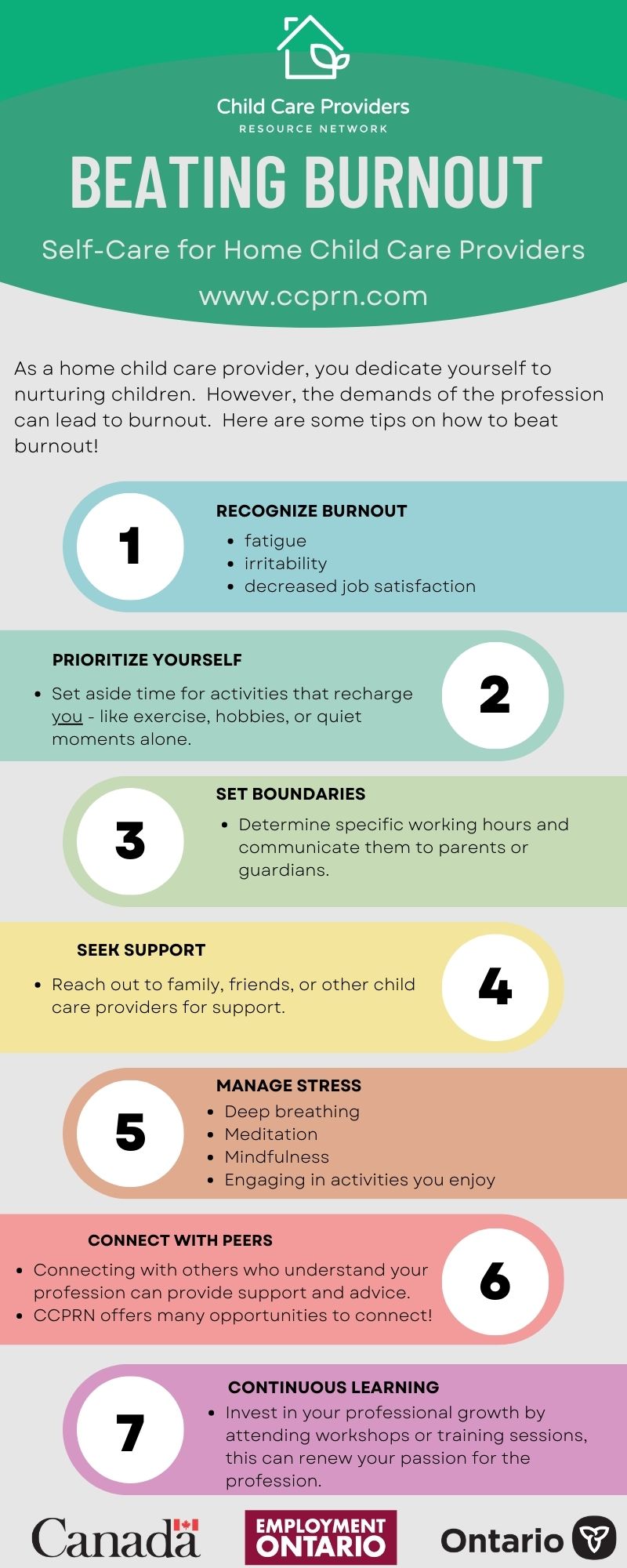
Empowering Growth: Growth Mindset for Parents and Caregivers
Written by Krystal Kirkwood, RECE
As parents and caregivers, we have the incredible opportunity to shape the mindset of our children. But it is equally important to develop a growth mindset within ourselves. By embracing a growth mindset, we can model resilience, inspire lifelong learning, and create a positive environment for our children. In this blog post, we will explore the differences between a growth mindset and a fixed mindset and share simple ways for parents and caregivers to foster a growth mindset within themselves.
A Growth Mindset will embrace challenges and personal development. A growth mindset means believing that our abilities and intelligence can be developed through effort and learning. It is about seeing challenges as opportunities for growth, rather than obstacles. With a growth mindset, we understand that our skills and capabilities can improve with dedication and practice.
A fixed mindset is when we believe that our abilities and intelligence are fixed traits that cannot significantly change. People with a fixed mindset tend to stay within their comfort zones, avoid challenges, and fear failure. They may believe that their skills are predetermined and limited.

Developing a Growth Mindset Within Ourselves as Parents and Caregivers:
- Embrace New Challenges: Step outside of your comfort zone and embrace new challenges. Take on tasks or learn new skills that you have always wanted to explore. By doing so, you model the courage to grow and inspire your children to do the same.
- Learn from Mistakes: Embrace the idea that mistakes are valuable learning experiences. Instead of dwelling on failures, focus on the lessons learned and the improvements you can make. Show your children that mistakes are not setbacks, but steppingstones to success.
- Cultivate a Love for Learning: Set aside time for your personal growth and learning. Pursue hobbies, read books, take online courses, or engage in activities that stimulate your mind. Share your newfound knowledge and excitement with your children, inspiring their curiosity and love for learning.
- Practice Positive Self-Talk: Be aware of your own self-talk and challenge any negative or limiting beliefs. Replace self-doubt with self-encouragement and affirmations. Cultivate a mindset that believes in your own capacity to learn and grow.
- Set Realistic Goals: Set goals for yourself and break them down into manageable steps. Celebrate your progress along the way, acknowledging the effort you put in. By demonstrating goal setting and perseverance, you teach your children the value of continuous improvement.
- Seek Support and Collaboration: Surround yourself with like-minded individuals who also embrace a growth mindset. Engage in discussions, seek advice, and collaborate with others who share your desire for personal growth. Create a support system that fosters growth and resilience.
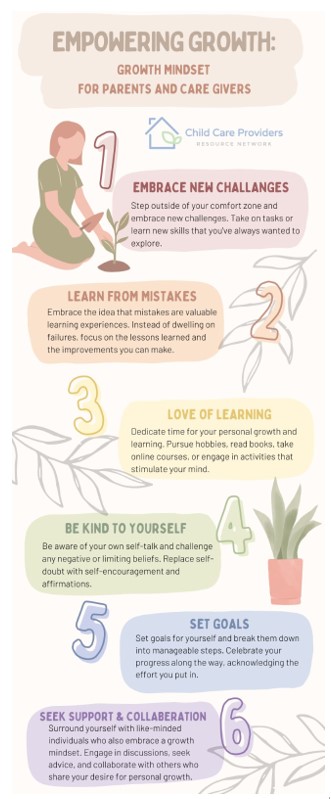
When we practice the skills of growth mindset as parents and caregivers, we can become powerful role models for our children. As you foster a growth mindset within yourself, you will create an environment that encourages your children to embrace challenges, persevere through obstacles, and unlock endless possibilities. Join us on this journey of growth together and inspire children to believe in their ability to learn and achieve great things.
Empowering Growth: Nurturing a Growth Mindset in Children
Written by Krystal Kirkwood, RECE
As parents and caregivers, we want to see our children thrive and reach their full potential. One important factor in their success is their mindset. In this blog post, we’ll explore the differences between a growth mindset and a fixed mindset and share simple ways to nurture a growth mindset in the children you care for.
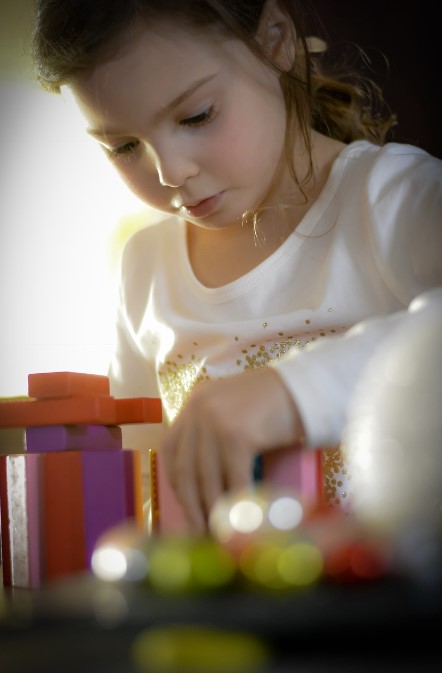
Understanding Growth Mindset:
With a growth mindset we can embrace challenges and learn from mistakes. A growth mindset is when children believe they can improve their abilities through practice and effort. They see challenges as opportunities to grow and learn. They understand that that it’s ok to make mistakes and can learn from them.
Exploring Fixed Mindset:
With a fixed mindset we are stuck in limitations and fear of failure. A fixed mindset is when children believe their abilities are fixed traits. They may avoid challenges because they fear failure and believe that making mistakes means they’re not smart or talented enough.
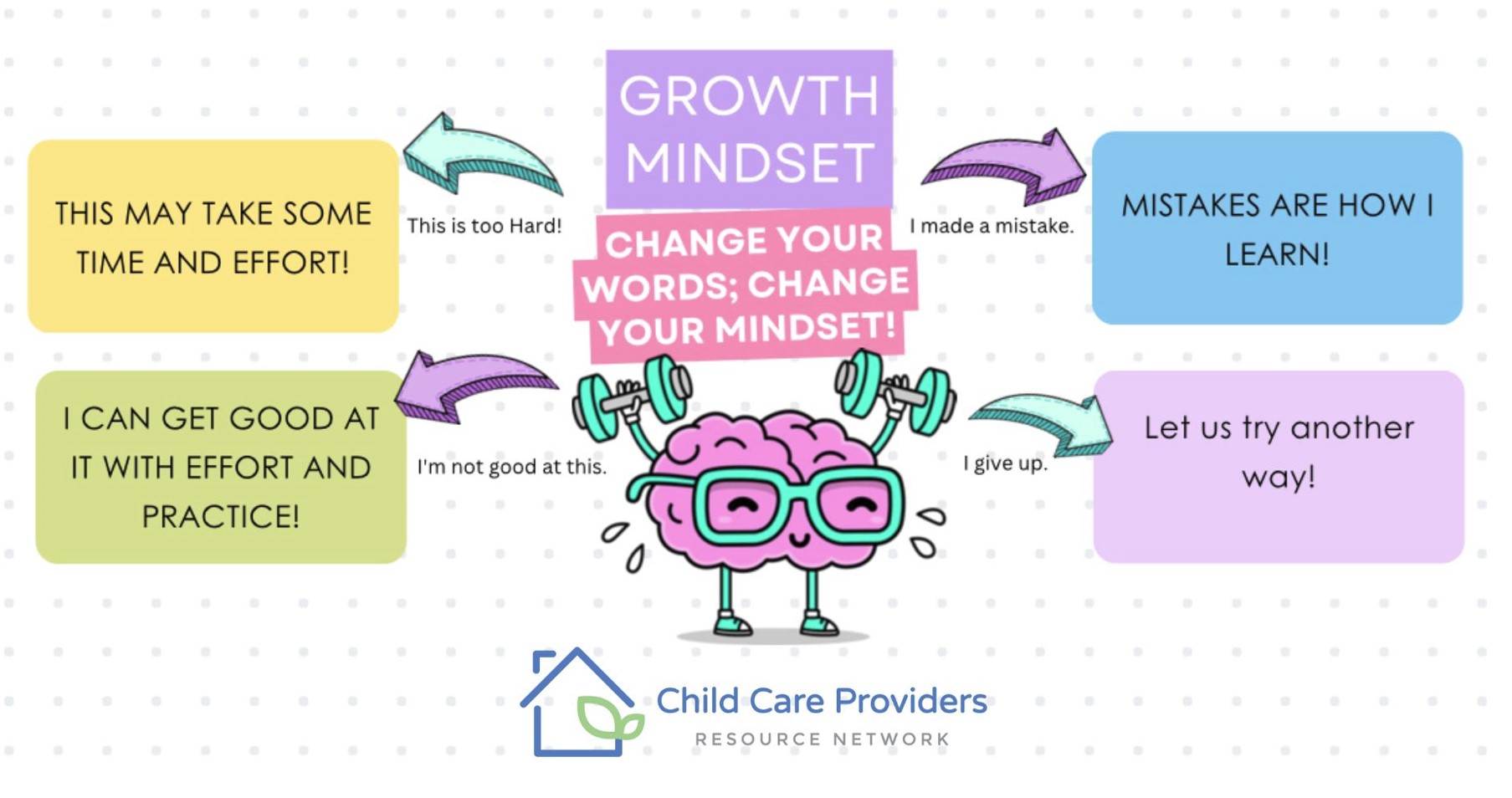
Fostering a Growth Mindset in Children:
- Encouraging Effort and Progress: Focus on praising the child’s efforts and the progress they make, rather than their achievements. E.g., “Wow that was really hard for you, but you kept trying, you did it!” This will teach them that hard work and perseverance are more important than success.
- Teach the power of “yet”: When your child says, “I can’t do that!” add the word “yet” to the end. This simple word encourages them to believe in their ability to learn.
- Emphasize the learning process: Help the children in your care to understand that learning is a journey. Encourage curiosity, exploration, and a love for learning new things. Show them that mistakes are opportunities to learn and improve.
- Set realistic goals: Help the children set achievable goals that require effort and progress. Break bigger goals into smaller steps and celebrate their accomplishments. E.g., The child who is learning to zip up their zipper independently. You can start the zipper for them, but don’t zip it up all the way, allow the child to do this. Then say, “YOU DID IT!” with excitement. This will build their confidence and motivation.
- Be a role model: Children learn by observing their parents and caregivers. Model a growth mindset by sharing stories of your own challenges and how you overcame them. Show them that setbacks are temporary and how “sticking with it” leads to growth.
- Provide support an encouragement: offer kind guidance and support when your child faces difficulties. Encourage them to try different strategies and provide positive reinforcements for their efforts, regardless of the outcome.
By nurturing a growth mindset in children, we empower them to approach challenges with resilience, and foster a love for lifelong learning. Encourage effort, teach the power of “yet”, emphasize the learning process, set realistic goals, be a role model, and provide support. With your positive guidance and belief in their ability to learn, the children in your care will develop a mindset that opens doors to endless possibilities.
Caring for Caterpillars
Written by Julie Bisnath, BSW RSW
Perfect for a home or child care environment, welcoming live caterpillars is easy and engaging. The caterpillars arrive in their own individual cups with their food included. You provide the habitat, which can be as simple as a jar or small mesh laundry hamper. Once the butterflies emerge, they spend a couple of days drying their wings, providing lots of time for up-close observation. On a nice day, release the butterflies in your yard or garden.
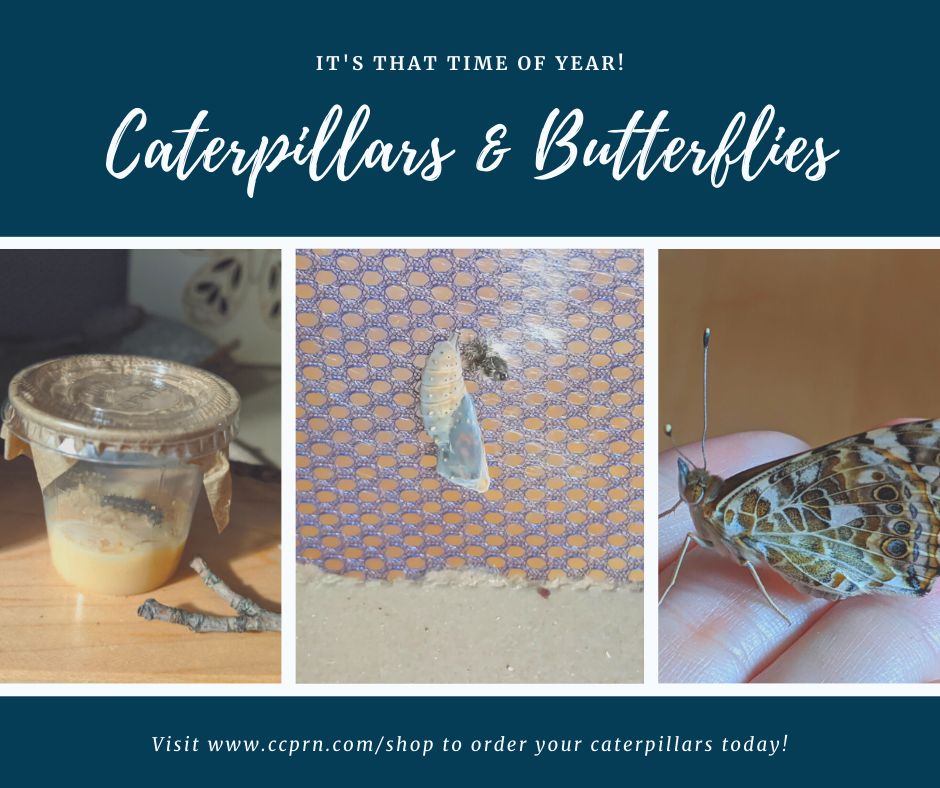
This wonderful experience offers many opportunities to:
- invite children to explore and enjoy caterpillars and butterflies up close
- inspire curiosity and a love for nature
- help children make meaningful connections to the environment & the world around them
- encourage children to wonder and develop their own theories
- examine nature from a scientific perspective
- foster a love for and gentleness toward all living things
Ready to get started?
- Order your Painted Lady caterpillars online at ccprn.com/shop
- 5/$35
- Pick-up your caterpillars in early June 2025 (exact date to be confirmed closer to June, pick-up will be in the evening) in Orleans, Ottawa Central, Barrhaven, or Stittsville.
- Observe and enjoy watching them grow. After 1-2 weeks they will transform into the chrysalis and in 8-10 days will emerge as butterflies.
- Observe and enjoy the butterflies for a few days and then release them outside.
Caring for your caterpillars and butterflies:
5 caterpillars will come in one small container with a cover. In the container with the caterpillars, there is a spoonful of artificial diet (soya flour based).
Leave the container on a shelf away from direct sunlight (and away from pets!) and at room temperature. You can open the cup for a closer look and even very gently hold the caterpillar. The caterpillars grow quickly! Be sure to spend some time enjoying this stage.
The images below feature 1 caterpillar per cup. The 2025 order will be 5 caterpillars per cup.
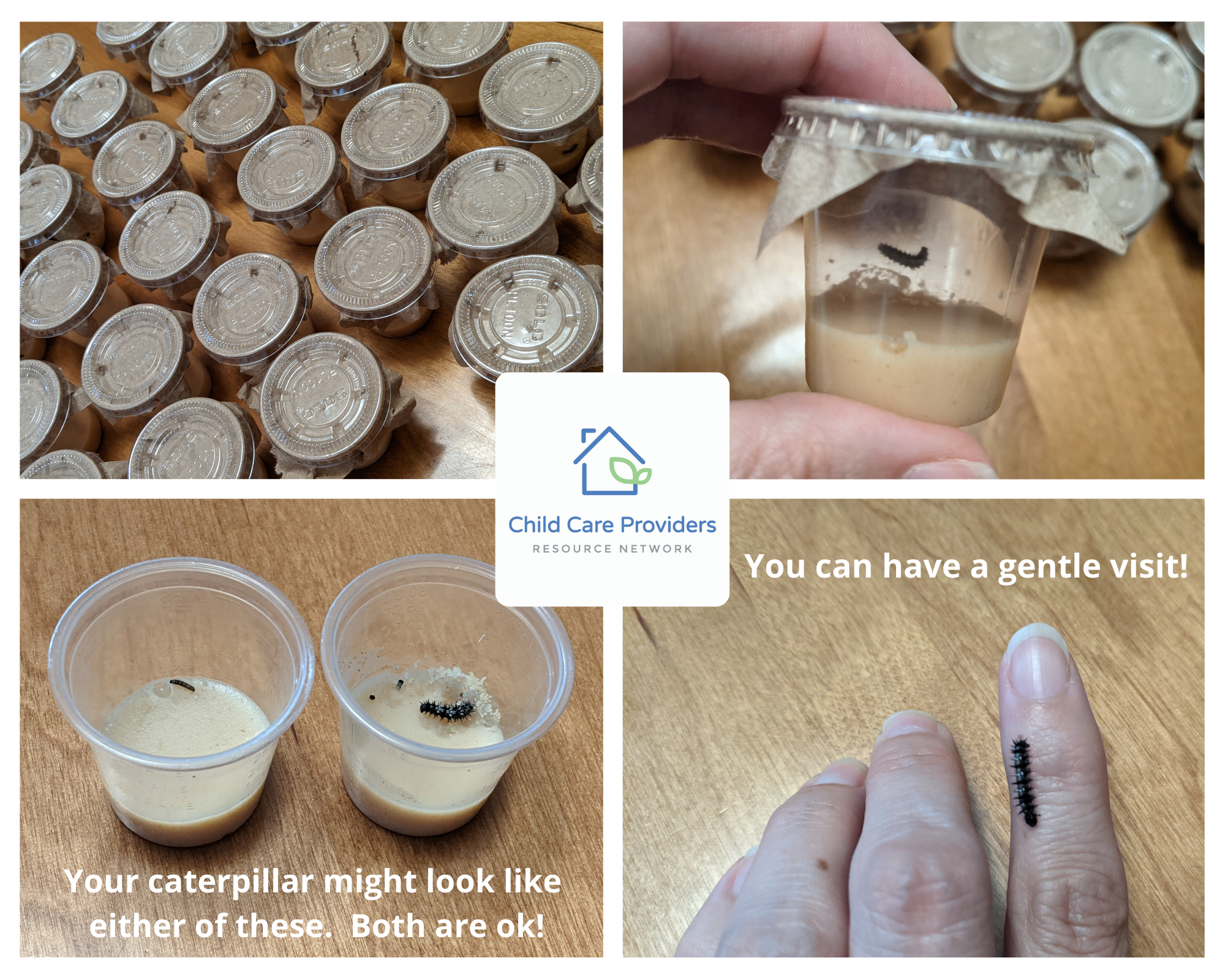
The caterpillars will manage alone and when they are finished feeding, they will push away the frass (caterpillar poop!), hang upside down and transform into a chrysalis or pupa without your help.
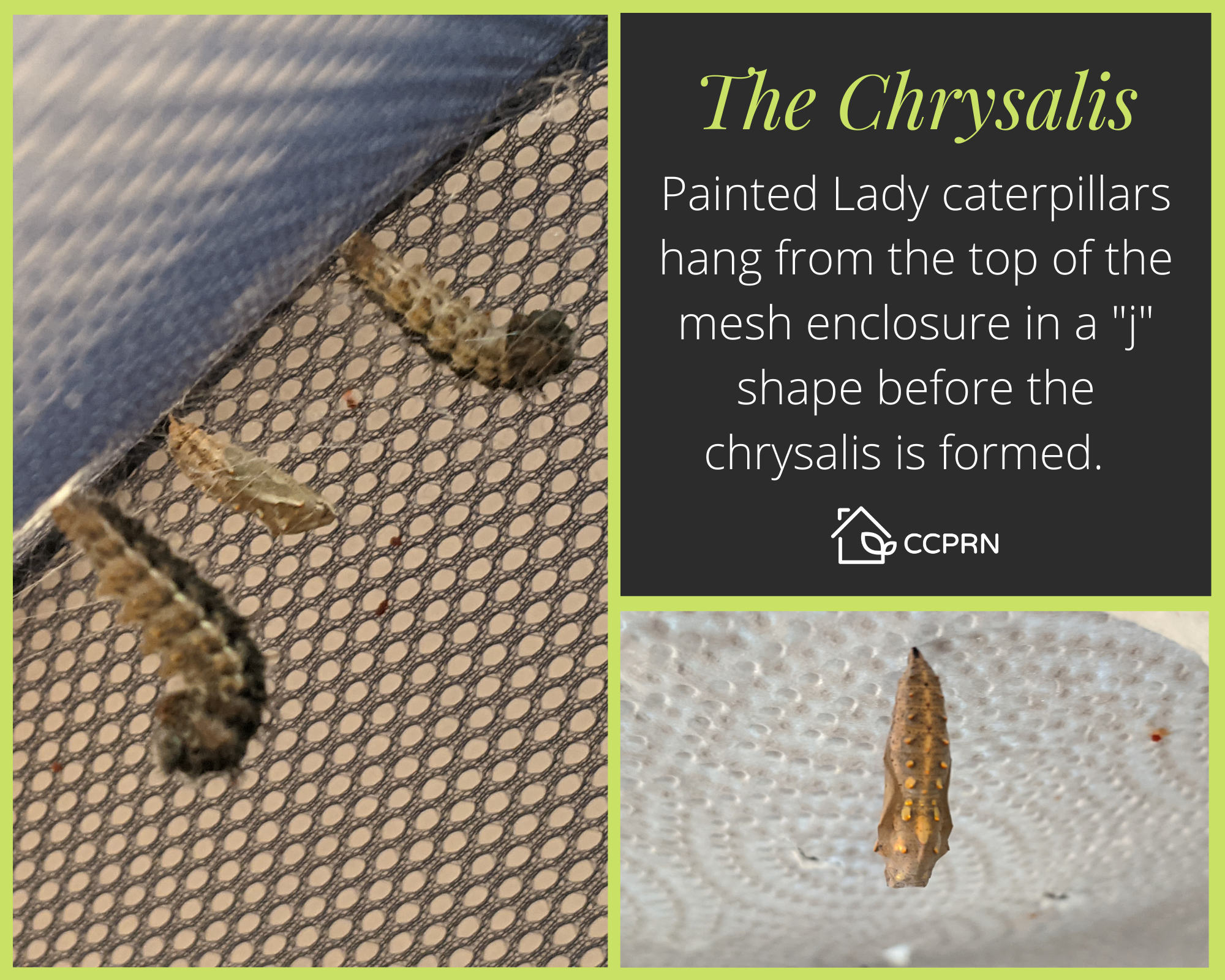
When this happens do not disturb the pupa for 72 hours until it has dried, hardened, and is solid.
Once the pupa is dried and solid, pull the paper towel and chrysalis from the container and pin it into a small flight cage (small mesh hamper—good if you have several caterpillars), about three inches from the bottom. It must be high enough for the butterfly to spread its wings completely and dry them when it emerges. If the pupa is pinned too high in the cage, the butterfly could fall and hurt itself. If the emerging butterfly falls from its chrysalis, it must be able to crawl up again in a hurry to dry its wing, so your flight cage must have a rough wall for it to crawl up. Slippery plastic or glass containers will not do the trick unless you add a wooden branch.
Alternatively, you can place the paper towel and chrysalis on the bottom of a jar or bug container. Include a stick to allow the butterfly to hang from once it emerges. Be sure to cover your jar with some sort of breathable material (mesh, a piece of screen, etc.).
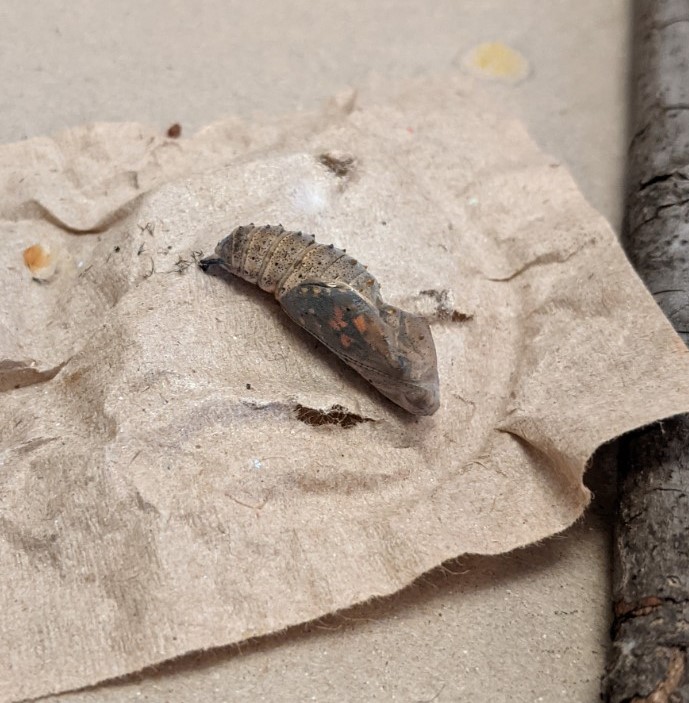
Once the chrysalis becomes translucent, the butterfly will soon emerge. The paper towel and chrysalis shown above were placed at the bottom of the container. When the butterfly emerges it can climb onto the stick and up the branch (not shown) where it will dry its wings.
In all, the pupa stage will last eight to ten days. Once the butterflies emerge, they will spend some time (could be a day or two) drying their wings. Place a slice or two of orange at the bottom of the enclosure for the butterflies to drink. Release the butterflies a day or two later into your yard or garden.
Another option:
When the caterpillars are quite large, open the lids of the tiny cups and place them into a larger jar or enclosure (make sure that the lid is breathable yet secure!). Provide sticks for climbing and when the caterpillars are done eating, they will climb to the top and hang directly from the mesh, or from a larger sheet of paper towel.
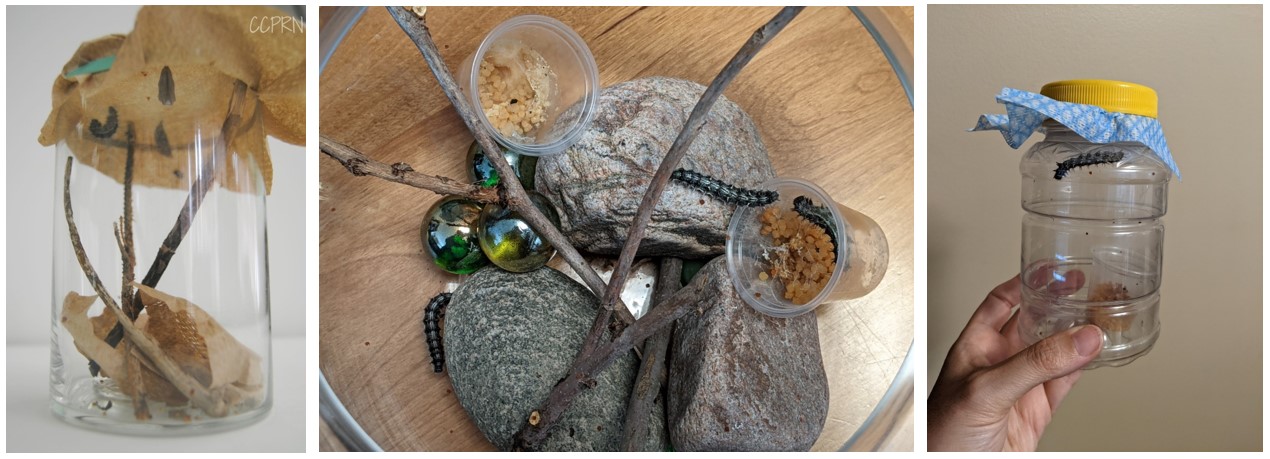
One caterpillar in a small jar or container is fine if you plan to release it as soon as the butterfly emerges. If you have several caterpillars and/or want to observe them for a couple of days as butterflies, then a larger enclosure is better. This could be a mesh laundry hamper, a small aquarium/terrarium, or even a clear plastic bin with a screen or mesh lid. Include sticks, rocks, and greenery so that the butterflies can climb up and spread its wings once emerged. Information on host plants for Painted Lady butterflies is abundant. Search it up online and you might learn that you already have the perfect host plant growing in your garden!
Several butterflies in a large mesh enclosure, soon to be released outside:
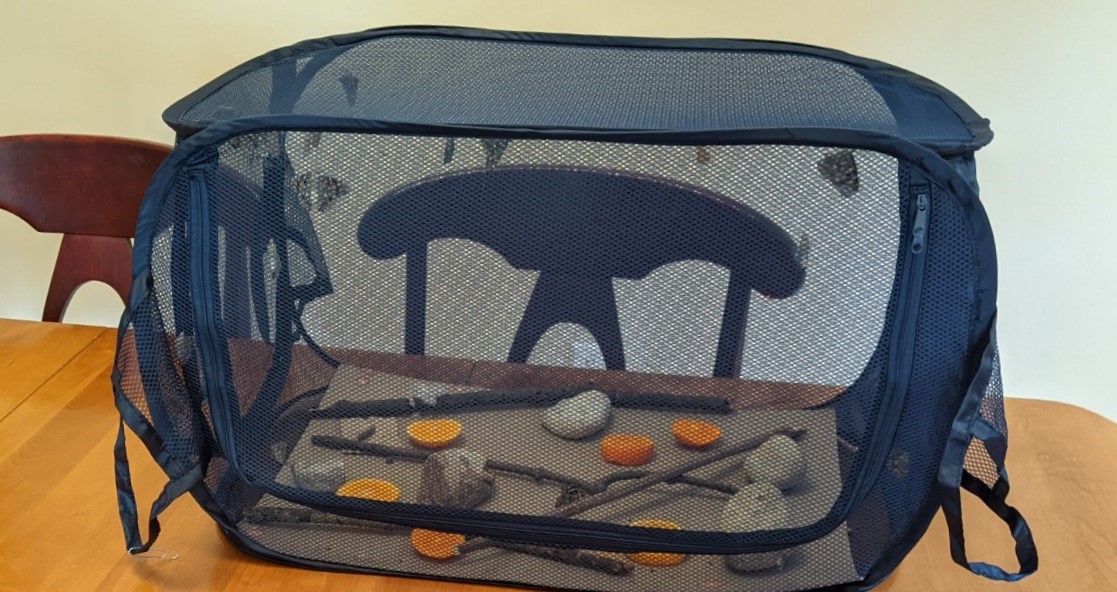
Release the butterflies on a warm day in your yard or at the park:

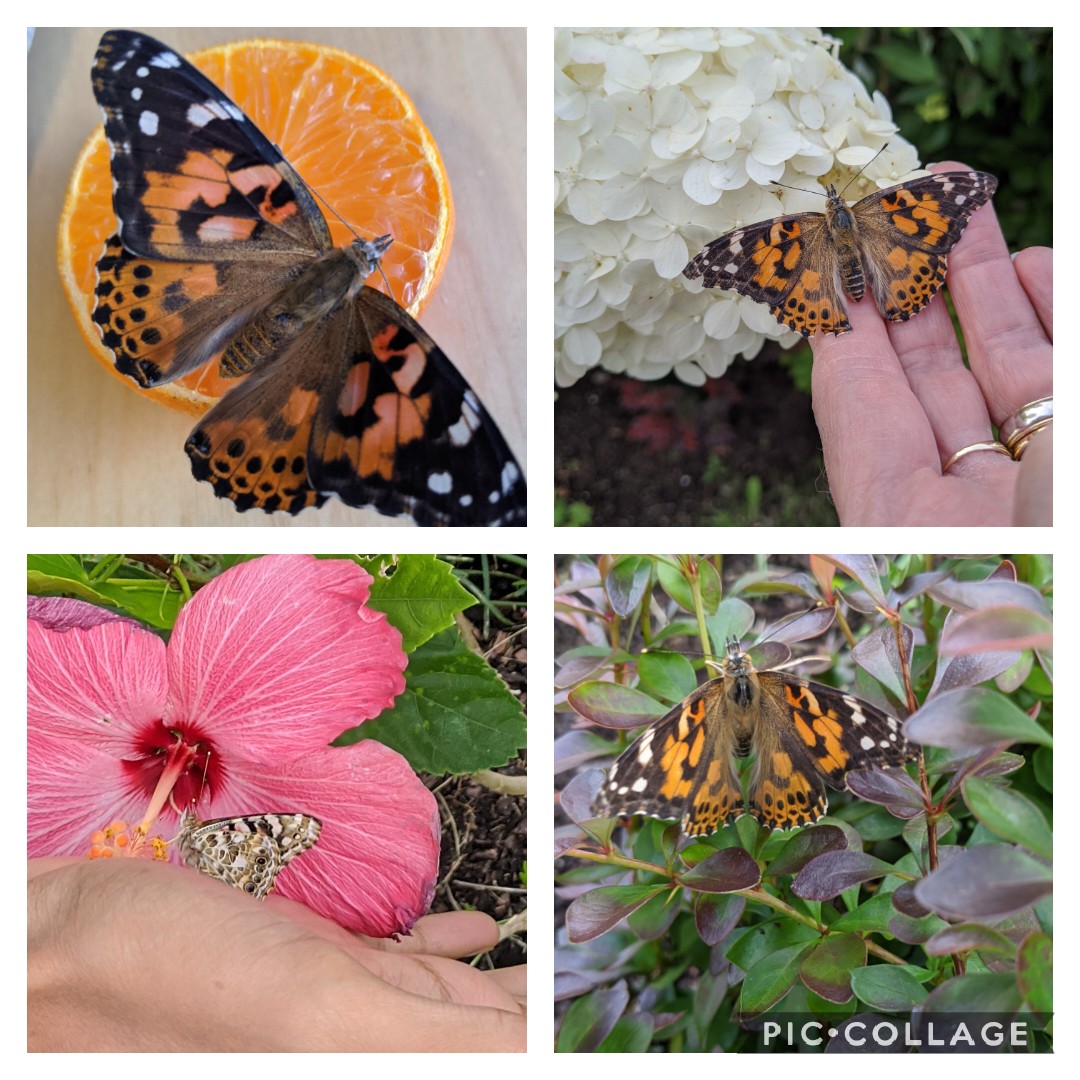
Using Visuals Supports—Schedules and So Much More!
Written by Julie Bisnath, BSW RSW
When I came across this great “visuals” reminder from Kristin Wiens (@kristin.wiens, @kwiens62) I thought that it would be good to share it along with a bit of information on the various types and benefits of using visuals with your children at home or at child care. While it might seem a bit daunting at first, using visual supports quickly becomes routine. I’ve used them both at home when my own children were little and in various professional capacities. I love these 9 great reasons identified by Wiens:
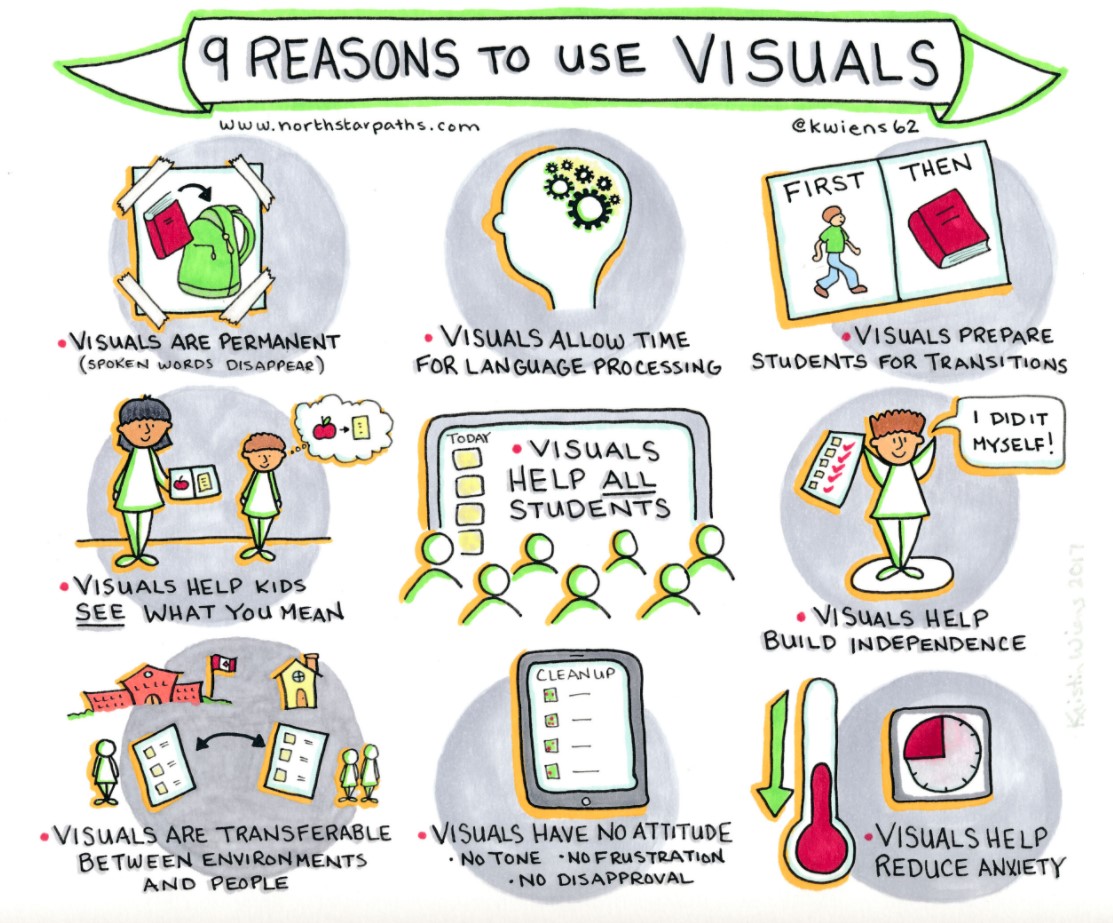
Visual cues benefit all children as they provide information, identify expectations, support communication, cue new skills, and enhance memory. Using them throughout your program supports skill development and promotes children’s independence. Examples of visual supports include photographs, line art, words, gestures, and actual objects—used consistently to convey information. Depending on how they are presented, visuals can be used for schedules, choice boards, labels, first/then boards, and sequencing charts.
A Visual Schedule reinforces the daily routine by providing a tangible way for children to see what comes next. Seeing the sequence of the day and learning to anticipate the routine reassures children and helps them to feel a sense of control over the environment. Simple graphics or actual photos of the children in the home or child care environment work well. Velcro or magnets on laminated cards make it easy for you to adjust the schedule as needed and allow the children to actively participate in removing the activities from the schedule once done. If wall or fridge space is not an option, the visual schedule can be easily strung up on a line with clothespins or assembled in a binder.
Many sample visual schedules can be found online. A simple example might include:
- indoor play
- snack
- outdoor play
- story or circle
- lunch
- nap
- snack
- outdoor play
- pick up
It’s also easy to add in extra activities such as going for a walk or tasks like bathroom visits and hand washing.

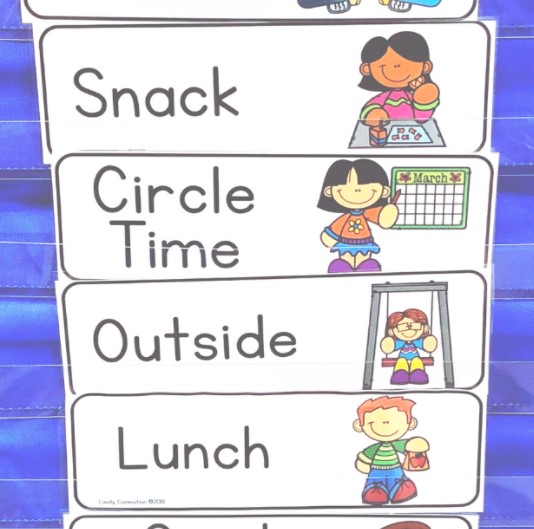
image on the left: www.thedandyliondaycar.wixsite.com/dlhdc
image on the right: www.lovelycommotion.com/blog/benefits-visual-schedule
Choice Boards provide information about what options are available and prompt children to make a choice. This can be a choice between two play activities, two objects, two foods, etc. Once the children are comfortable choosing between two options, you can gradually increase the choice board to include more possibilities. A choice board with multiple favourite activities/items is sometimes called an “I Want Board” and is used more commonly as a communication tool but can also be helpful in a group setting such as home child care. Here is a wonderful example of a choice board (or “I want board”) in use by a classroom teacher. Each student chooses how they would like to be greeted from choices on the board (hug, bow, high five, fist bump, dance, or handshake.): https://www.youtube.com/watch?v=NmXuhgWjMJg
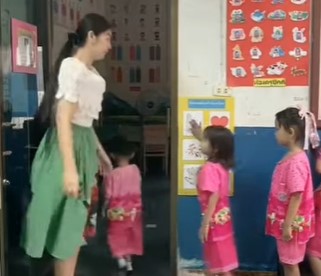
For choosing between two places (i.e., playing at the park or in the backyard), photographs work well. For choice between two objects, or two foods, you can use the actual items if you prefer. Choice boards themselves (compared to simply holding up or pointing to the actual choices) cue the child that they are about to be presented with a choice, sometimes this in itself is helpful. In this case, using a consistent “board” (a dedicated clipboard for example) is easiest and most effective. Whether you use an actual board or not, the key feature is to only present available options. The adult determines the available options, and the children get to choose their preference. Eventually, children who are comfortable making choices will not need as many visual cues for everyday decision making.
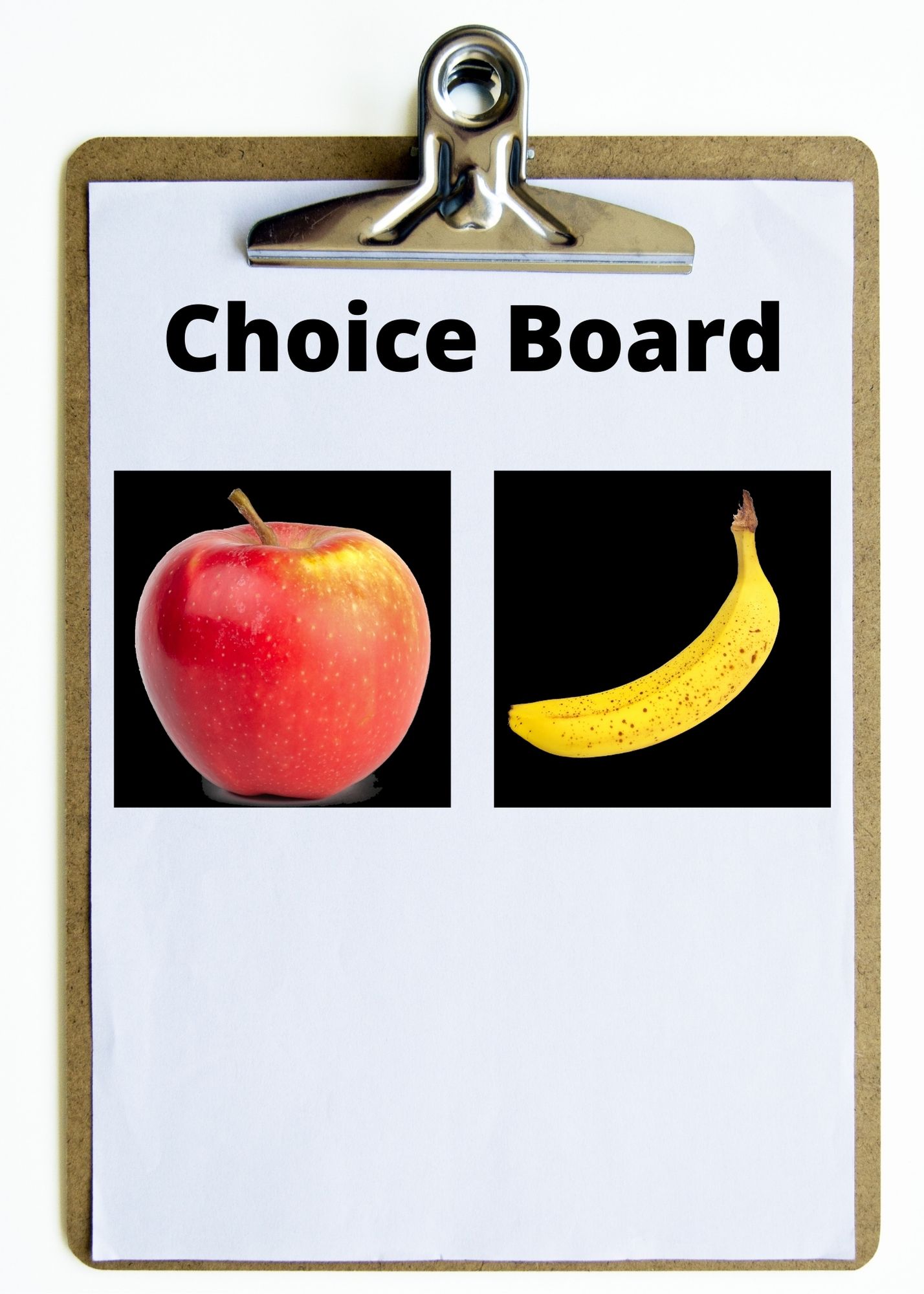
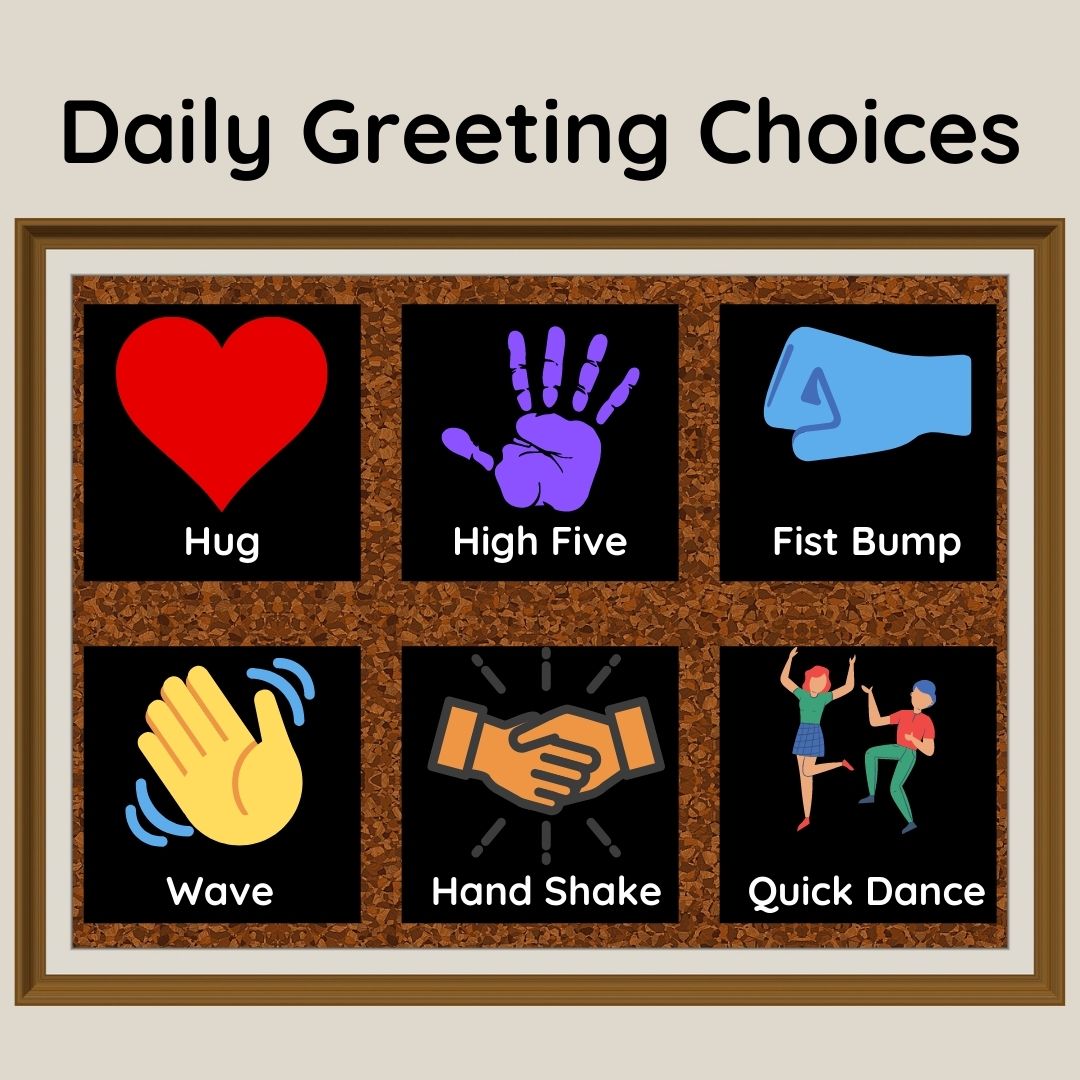
Labels help us all to know where things belong—use simple pictures or words to identify the room, area, bin, or cupboard. Labelling personal cubbies and/or playroom toy bins, for example, supports independent self-help skills and contributes to group tasks such as tidying up.
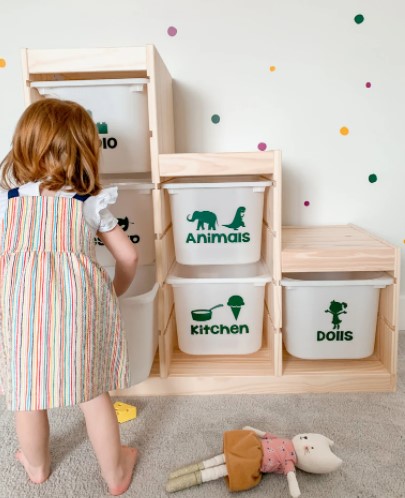
Photo from: www.etsy.com/ca/shop/TaraMichelleHome?ref=simple-shop-header-name&listing_id=780666589
Some home child care providers assign a colour to each child. This is another type of visual cue and can include items such as personal bins (red bin is for child A’s hats, mitts, and bag while blue bin is for child B’s belongings, etc.), snack and lunch dishes, facecloth and towel, water bottles, etc. The important thing here is to be consistent in maintaining the colour assignments.
First/Then Boards indicate a sequence of events and are helpful during transitions. The “first” picture is an activity that you need the child/children to do followed by the “then” picture of an activity or object that the child/children enjoy. Help them to complete the sequence and be sure to follow through. Make the “first” action easier and more interesting by pairing it with a little song—extend the song by repeating or making up verses to suit and/or prolong the task:
- Time to put the toys away, toys away, toys away, time to put the toys away, so we can play outside. (Tune of London Bridge)
This one in particular is super easy to adapt (no rhyming lol!).
- Now it’s time to wash your hands, wash your hands, wash your hands, now it’s time to wash your hands, so we can have our snack.
An easy little clean up rhyme:
- Clean up, clean up, everybody everywhere, clean up, clean up, everybody do your share.
And one for handwashing:
- Wash, wash, wash your hands, get them nice and clean! Wash the front and wash the back, and wash them in between. (Tune of Row, Row, Row Your Boat)
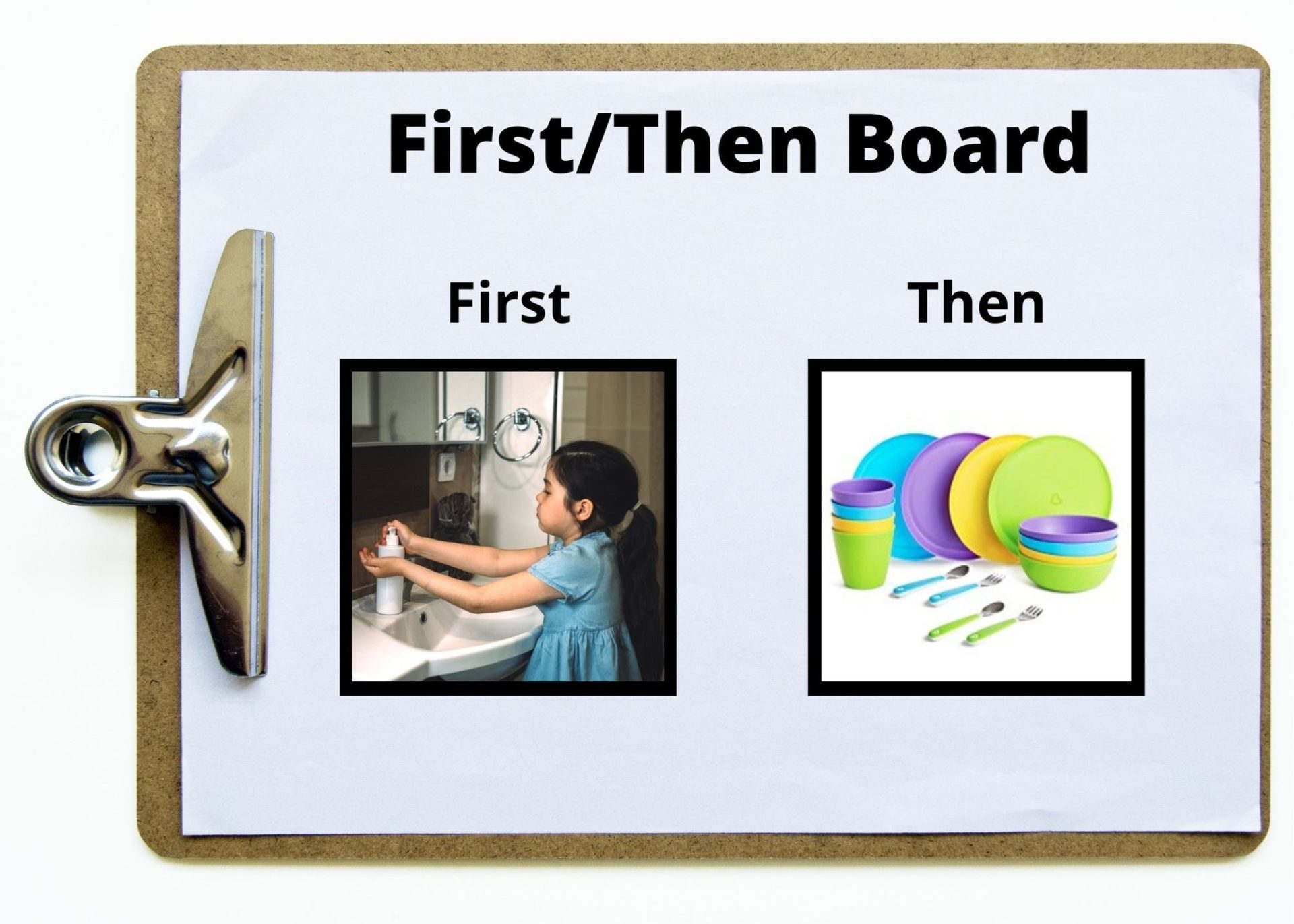
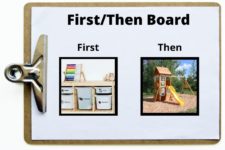
Sequencing Charts support children in learning a new skill. The skill is broken up into smaller, step by step tasks which are represented by a sequence of images. Sequencing charts are often used to teach and remind children about various routines—including handwashing, toileting, and dressing. Sesame Street offers a printable handwashing sequence here: https://sesamestreetincommunities.org/activities/teaching-handwashing/.
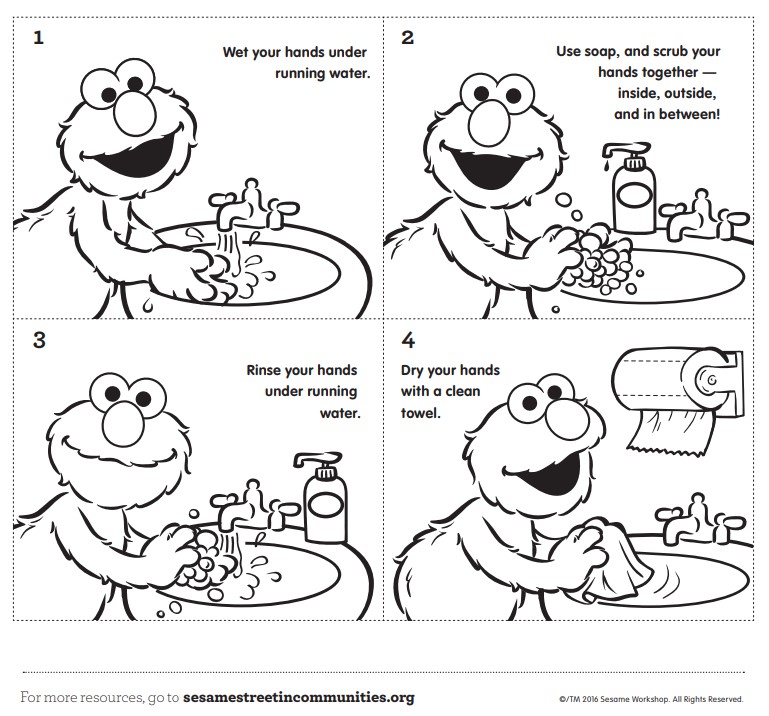
Just as adults use and rely on various visual cues (traffic signs, calendars, post-it notes, etc.), so do children. Not only do these supports serve as important reminders, but they also establish expectations, promote language development, encourage autonomy, and provide comfort in knowing what’s coming up next.
With reference to decision making, linking visual supports when you communicate with children helps to keep their attention, gives context to your words, and provides a concrete reference for making a choice. Think of a restaurant menu–isn’t it so much easier to make a choice when you have a menu to look at? Isn’t even nicer when the menu features appetizing photos? What about when you want to order something that you’re not sure how to pronounce or that might be in another language? Pointing to your choice is pretty handy. Listening to the server rattle off the options could also work but an actual menu really does enhance the experience.
Children are constantly working to process information and make sense of the world around them–providing visual cues supports their growth and development as capable and competent learners.
No matter what type of visuals you use, be sure to present them at the children’s eye level and keep them in a consistent location (i.e., a dedicated spot on the wall for the daily schedule and/or the daily greetings, use a dedicated clipboard or binder for a choice or first/then board). If you haven’t used visual supports in your home or child care program, give it a try—you’ll soon see the many benefits for both you and the children in your care.
